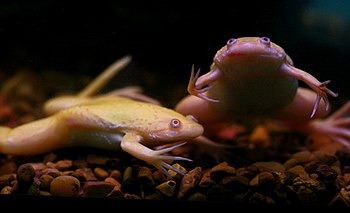Anthias are members of the family Serranidae. Several different genera comprise this family including; Pseudanthias, Nemanthias, and Serranocirrhiti. All are collectively referred to as anthias. The anthias most familiar to saltwater aquarium owners belong to the genus Pseudanthia. There are several species within this genius. This article is meant to be a generalized description of the genus.
 |
| Anthias anthias - Photo: Wikimedia |
Anthias inhabit all the topical oceans and seas around the world. These are considered the quintessential reef fish and often account for the majority of the fish population swarming around tropical reefs.
Anthias are typically among the smaller more docile fishes made available by the saltwater aquarium industry. These are extremely popular ornamental fish because of their intense and varied coloring. Common color variations found among Anthias include pink, purple, orange and yellow. They will live an average of five years but have been known to live as long as eight.
Anthias are generally considered hardy fish in their natural habitat but they have been known to have problems adapting to a life of captivity. They are quite often traumatized to the point of not bothering to eat. They have frequently been known to starve themselves to death. It is strongly recommended that you ask your fish store to watch them eat before purchasing them. If they are feeding they will be more apt to acclimate to your aquarium. Live food will often aid in the acclimation process.
These are a shoaling fish. In nature they congregate by the thousands very often schooling in larger populations. There are innate subdivisions within these schools typically referred to as harems. Harems have a hierarchical order. This hierarchy is comprised of one dominate and up to two subdominant males. Subdominant males are generally smaller and less colorful. And what is a harem without a female population? There are often as many as twelve females populating the harem all of which have their own hierarchy.
Anthais are considered good additions to a community tank. They are "reef safe" and are accustomed to living with a variety of other species. They range from 1.5 to 5 inches depending on their particular species. The size of a specific species should be inquired about to select suitable tank mates. You want to raise them with other mild mannered species. Despite their inherent nature to live in communities a single Anthais can be added to your tank. However several will allow you to watch them act as nature intended. A new arrival will often adapt to unfamiliar surroundings if you already have an established anthais community in your aquarium. Unless you have a very large tank you will want to have a single male to avoid territorial issues. However a few may establish a social order. A harem of females is appropriate when raising theses fish in a community. Anthais prefer subdued lighting. They are hiders by nature and should be provided with plenty of plants, rock work or hollow aquarium décor.
Anthias are dither fish. They communicate with each other. They will warn each other if there is danger approaching and then issue an all is clear signal once the potential threat has passed.
Anthias are protogynous hermaphrodites. All species are born as females. If the dominant male of the harem perishes this event will often trigger a hormonal response in the largest female transforming her into a male. This can lead to aggressive behavior between the two. The dominant male views the largest female as his potential replacement, while the largest female's body is surging with testosterone because of her rank in the harem's social structure.
Anthias are Zooplankton feeders. Zooplankton are microscopic organisms that float in the oceans and seas of the world. They typically float in columns. These columns are inhabited by crustacean larva, and extremely smaFll crustaceans like daphnia, and radiolarians.
Zooplankton can be purchased commercially. Anthias can also be fed vitamin enriched brine shrimp, other varieties of tiny crustaceans as well as frozen protein enriched food for marine fish. Anthias are active fish with healthy appetites and should be fed at least three times a day.
Many home aquarium owners cringe at the thought of maintaining a saltwater aquarium. What most of them don't realize is that a Jellyfish Fish Tank Aquarium requires little more maintenance than a freshwater tank. Keeping Pet Moon Jellyfish is the hottest new trend in aquarium ownership. Article Source: EzineArticles |







